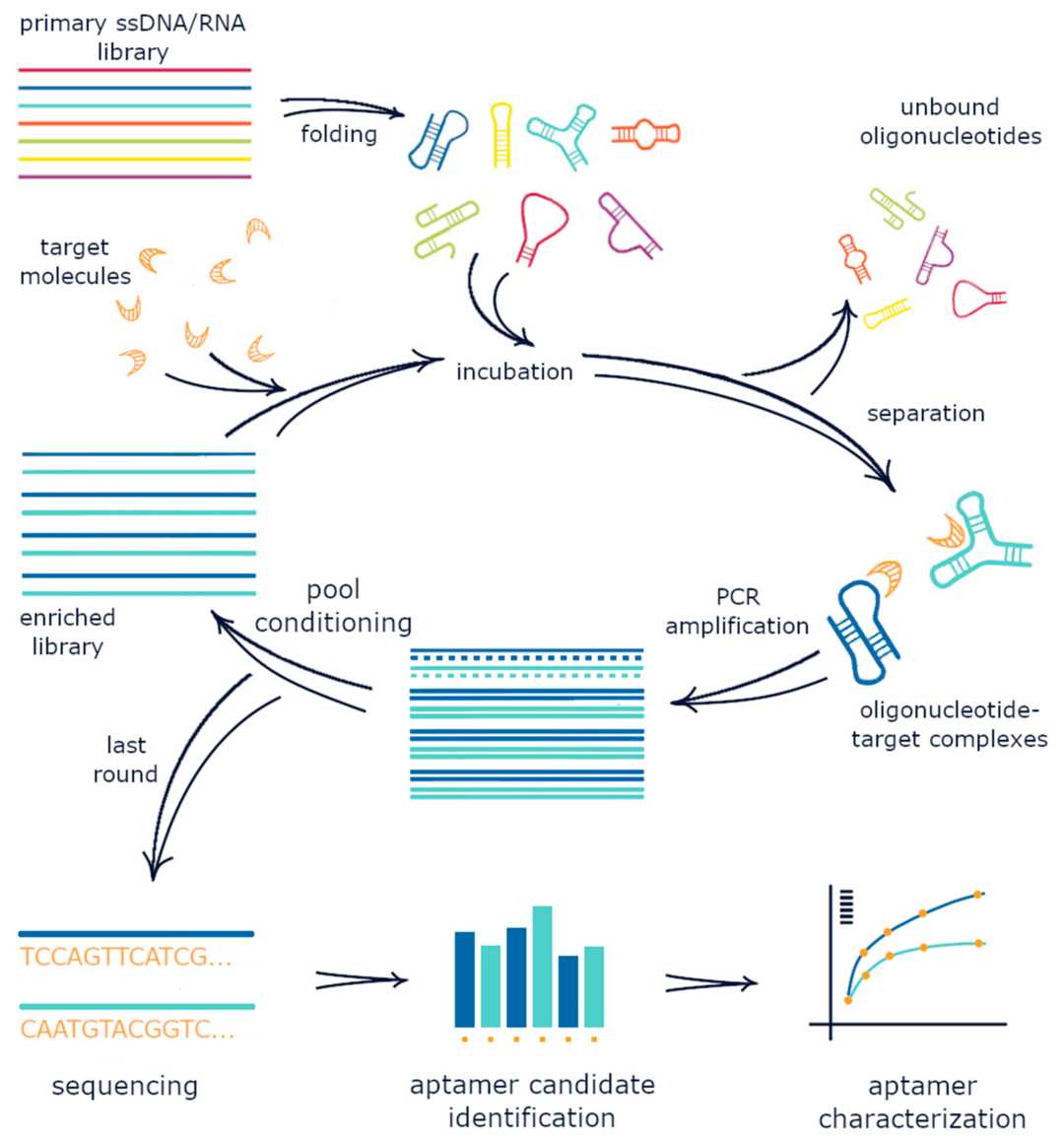Comparing with antibodies, aptamers have extra advantages, such as easy synthesis, low cost, convenient modification with different functional groups, flexible design, and low immunogenicity. Therefore, aptamers are attractive affinity reagents for biomarker discovery. Based on years of professional experience, Creative Biolabs provides high-quality aptamer development services to global researchers.
Introduction of Systematic Evolution of Ligands by Exponential Enrichment (SELEX)
Aptamer and SELEX technology have brought a revolution to biomedical fields since their introduction in 1990. The main impediments to aptamer development and application are their suboptimal bioavailability and shortcomings in the SELEX process. As an improved strategy, unlike conventional SELEX using purified proteins as targets, the cell-SELEX method uses whole living cells (target cells and control cells) to generate membrane protein-specific aptamers. Therefore, cell-SELEX has obvious advantages over conventional SELEX. Firstly, since the target proteins are in situ during the screening process, proteins are preserved in intact and native conformation, which minimizes the probability of selecting physically nonspecific aptamers. In addition, owing to without any prior knowledge on conformation or abundance of target proteins, cell-SELEX is an unbiased method to explore novel cell-surface protein biomarkers for different types of cancerous cells. And, via targeting the entire cell membrane containing different receptors, a pool of aptamers can be systematically generated.
 Fig. 1 Schematic representation of cell-SELEX.1, 2
Fig. 1 Schematic representation of cell-SELEX.1, 2
Aptamer for Biomarker Discovery
Novel biomarker discovery is urgently needed in the personalized cancer research field. To this aim, Cell-SELEX can be used as a powerful tool for novel biomarker discovery without prior knowledge of biomarkers present on tumor cell surfaces. Cell membrane protein biomarker discovery based on cell-SELEX generally takes a three-step process:(1) developing aptamer probes against target cells with ideal specificity and affinity; (2) aptamer-assisted isolation and purification of target proteins; (3) identifying target protein biomarkers by mass spectrometry. For example, a biotinylated aptamer, sgc8, was utilized to identify PTK7 in many types of cancer cells. The biology of PTK7, a pseudokinase without tyrosine kinase activity, was previously rarely studied. The discovery, enabled by aptamers, of the differentiation of PTK7 expression in cancer cells and many healthy cells (except stem cells), implied the potential correlation of upregulated PTK7 expression in cancer development and the potential value of PTK7 as a diagnosis or therapy targets.
Services at Creative Biolabs
Focusing on biomarker discovery, Creative Biolabs, a global-leading CRO company, has been committed to the research of the aptamer application in biomarker discovery for years. Our comprehensive technology platform with mature technicians will provide quality-reliable technical services. The specialist team will customize the optimal experiment scheme for you and offer consultation service during the process of aptamer development.
Why Us?
-
Professional and reliable
-
Efficient and cost-effective
-
Top-rated customers experience
-
Flexible and customized services
The aptamer is becoming a novel tool for biomarker discovery. Based on excellent industry reputation and powerful technology, Creative Biolabs has become a leading customize services provider in the field of aptamer development and aptamer application research services. If you have any questions, please feel free to contact us for more information.
References
-
Komarova, Natalia, and Alexander Kuznetsov. "Inside the black box: what makes SELEX better?" Molecules 24.19 (2019): 3598.
-
under Open Access license CC BY 4.0, without modification
Related Product
Questions & Answer
A: Aptamers offer several advantages, such as high affinity and specificity for their target biomarkers, ease of synthesis and modification, stability, and low immunogenicity. They can also be easily integrated into various detection platforms.
A: Aptamers can be used to identify and isolate biomarkers from complex biological samples. They can be employed in techniques like aptamer-based affinity chromatography, aptamer microarrays, or aptamer-based biosensors to detect and quantify biomarkers.
A: Yes, there are several examples of successful aptamer applications in biomarker discovery. For instance, aptamers have been developed for biomarkers associated with cancer, infectious diseases, and neurological disorders, demonstrating their potential in diverse areas of research and diagnostics.
For Research Use Only.
Related Sections:

 Fig. 1 Schematic representation of cell-SELEX.1, 2
Fig. 1 Schematic representation of cell-SELEX.1, 2